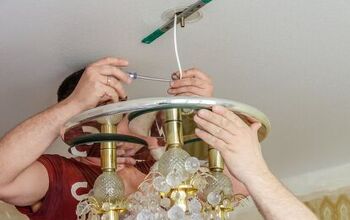How To Change Light Bulbs In A High Chandelier

Chandeliers are a worthy addition to dining halls, atriums, entrances, and other places around the house with high ceilings. They brighten the room and considerably raise the aesthetic appeal.
However, upkeep doesn’t come easy with these expensive light fixtures. For instance, when the time comes to change the light bulbs, a simple swivel and pull is not an option and a standard ladder isn’t high enough.
It’s still doable though, as long as you have the right equipment at hand.
Many people suggest using telescoping lamp changers to help you reach as high as 35 feet above the floor. But if these aren’t available in your area, good old trusty ladders are your other option. Ensure your safety while climbing these and you won’t have a problem. Lastly, you can install a chandelier lift and get a permanent solution that lets you reach high anytime you want to change bulbs or clean.
Be wary; bulbs are fragile, so follow the steps mentioned below to avoid mishaps!
Read on to know more.
Do You Need to Hire an Electrician?
Get free, zero-commitment quotes from pro contractors near you.

Why Would You Need To Change The Bulbs In The First Place?
Changing a light bulb is something all of us have done frequently, but why does replacement become necessary? Here are some of the many reasons:
- The bulb doesn’t light up anymore
- The glass or inner filament are broken
- The bulb flickers now and then (maybe the fault is with the circuit breaker and not the bulb; review this article to know more)
- You need to install smart bulbs that can be controlled via a smartphone
- You made the wise call of replacing standard bulbs with LEDs that do not require much power and have a generous 50,000-hour life span
- The standard bulb may be nearing its end-of-life as they work for 1,000 to 2,000 hours only
How To Change A Light Bulb In A Chandelier
The choice is yours, call in an expert and pay the price, or DIY the replacement with the right set of tools. The latter can get a little challenging because of the height, but once you get over the initial shock, it really isn’t all that difficult.
So if you are up for the challenge, there are three ways to go about changing a bulb:
- Use a ladder
- Use a telescoping bulb grabber
- Install a lift (permanent solution)
Let’s explore each option in detail:
Change A Light Bulb Using A Ladder
Before you get started, make sure that you are wearing rubber gloves; they will safeguard you against electric shocks.
Next, get a ladder that’s taller than the standard size. It would be best to measure the room’s height and buy a ladder accordingly.
Now follow these steps to replace the bulb:
- Switch of the light to avoid possibilities of getting electrocuted
- Make room for the ladder by clearing the surface it would stand on
- Keep the ladder near a wall, or on the ground, and ensure its stable before stepping on
- Bring in a friend or family member to hold the ladder to ensure it stays steady
- Climb up the ladder, and if the bulb in within any coverings; remove them
- Gently grip the bulb
- If you have a downward-facing bulb, rotate it counterclockwise, and if upward facing, do the opposite
- Now screw in the new bulb
- Turn the switch on to see if the bulb works
- Switch off the chandelier, and add back parts you had removed to access the bulb
Change A Light Bulb Using A Bulb Grabber
If you are scared of heights or fear that the ladder may topple, you can switch the light bulb using a bulb grabber.
The standard variant, along with an extension, is perfect for downward-facing bulbs, whereas you would need a sticky bulb grabber to unscrew an upward-facing bulb. A popular variant that flawlessly works for both types of bulbs is the Highlight Chandelier Light Bulb Changer for high ceilings.
Follow these steps to replace bulbs by using your bulb changer:
- Switch off the chandelier
- Wear rubber gloves
- Get the bulb grabber connected to an extension pole that heightens it to reach the bulb in question easily
- Very gently, keep the grabber on top of the bulb
- Grip the bulb in the provided notches
- Rotate the extended grabber to loosen the bulb
- Once unmounted, gently remove the bulb from the grabber by pulling the provided release string
- Put the new bulb on to the grabber and make way for the socket
- Once centered in the socket, start swilling
- When sure it’s properly inserted, let go of the bulb by pulling the release string
- Switch on the chandelier to ensure everything works fine
- Pull the release string to let go of the new bulb
Here is a piece we did on how to change a light bulb in a high ceiling; check it out as we explore different types of bulb grabbers.
Installing A Motorized Lift For Chandelier Maintenance
This is more of a permanent solution that connects a lift-based mechanism to your chandelier – whether you want to clean or replace bulbs – access the unit by bringing it down.
Though this task requires some expertise, so it would be best to consult professional help; but if you want to DIY, follow these steps.
Before you begin, make sure the following items are nearby:
- The motorized electric lift (obviously)
- Screwdriver
- Drill and bits
- Wire nuts
- Jigsaw
- Wire cutters
Now let’s start:
- Switch off the chandelier, and flip the breaker
- Disconnect the chandelier from the source, i.e., the electrical box
- There will be a hole right on top where the chandelier stood — place a magnetic, electric box over there
- There will be some access space above the ceiling, connect to the motorized winch to it. The chances are that you would need to build a structure on the access space, and then mount the winch to it by using the drill and screws
- Connect the lift to the electric source, and then connect the wires to the chandelier
- Connect the low voltage wires between the winch and the circuit board
- Bring down the low voltage wire from the motorized winch
- With the help of a screwdriver, connect the winch and motorized electric motor
- Cover up the winch
- Screw the main switch to the low voltage ring
- Now test the lift by bringing it down
- Connect the chandelier to plates via wire nuts
- If all is done correctly, the chandelier can now be turned on
- Now you can lower the chandelier to floor height with the touch of a button
Do You Need to Hire an Electrician?
Get free, zero-commitment quotes from pro contractors near you.

Related Questions
How Do I Dispose Of Old Light Bulbs?
You have to discard severed bulbs with care; tossing them in the garbage is not an option as they will break and hurt someone. The best way to safely dispose of is to cover it in old magazines or newspapers, or by putting them in the package that the new bulb came in.Above all, make sure that no child can reach the place where the bulb is thrown, as shreds of glass are dangerous.
Can You Electrocute Yourself While Changing A Light Bulb?
Yes, you can. That’s why it is in your best interest to ensure that the chandelier is switched off when replacing bulbs. But this solution only works in usual scenarios where the chandelier is wired correctly.These fixtures are constructed in a way that makes it very difficult to get electrocuted accidentally. However, the only foolproof way to save yourself from the risk of electrocution is by using the circuit breaker in the fuse box.
What Are High Ceilings?
Old homes came with eight-foot ceilings, whereas newer homes mostly feature a nine-foot ceiling. Anything above nine-foot is considered to be a high ceiling.Interestingly, two-story living rooms have become more prevalent in recent years. These rooms have ceilings as high as 20-feet that make for beautiful opulent spaces, perfect for a chandelier.

Ian Haynes is a digital marketing specialist and has successfully written hundreds of home improvement guides. Outside of his work, Ian likes fixing old bikes and exploring Brooklyn with his Labrador.
More by Ian Haynes



























